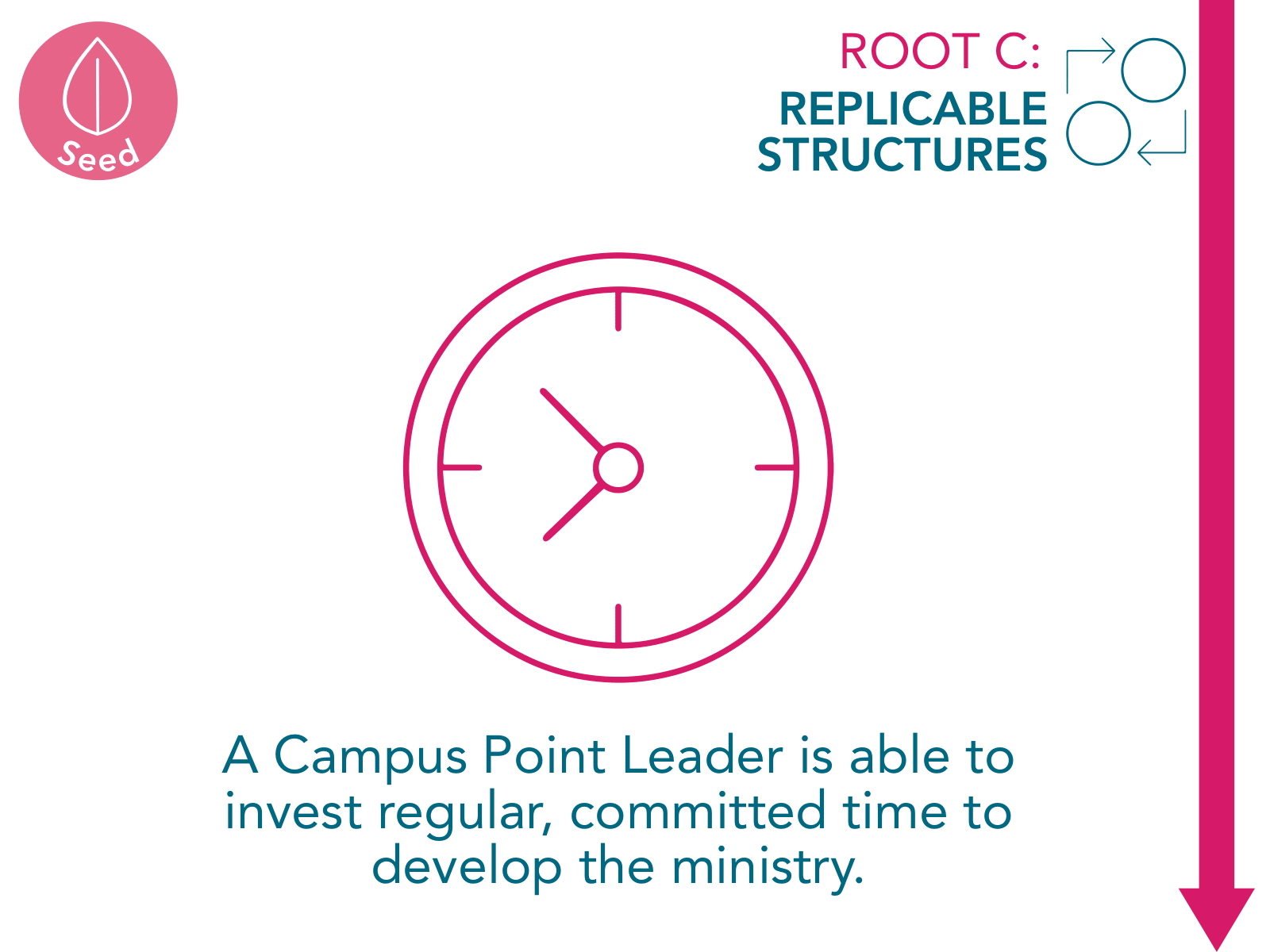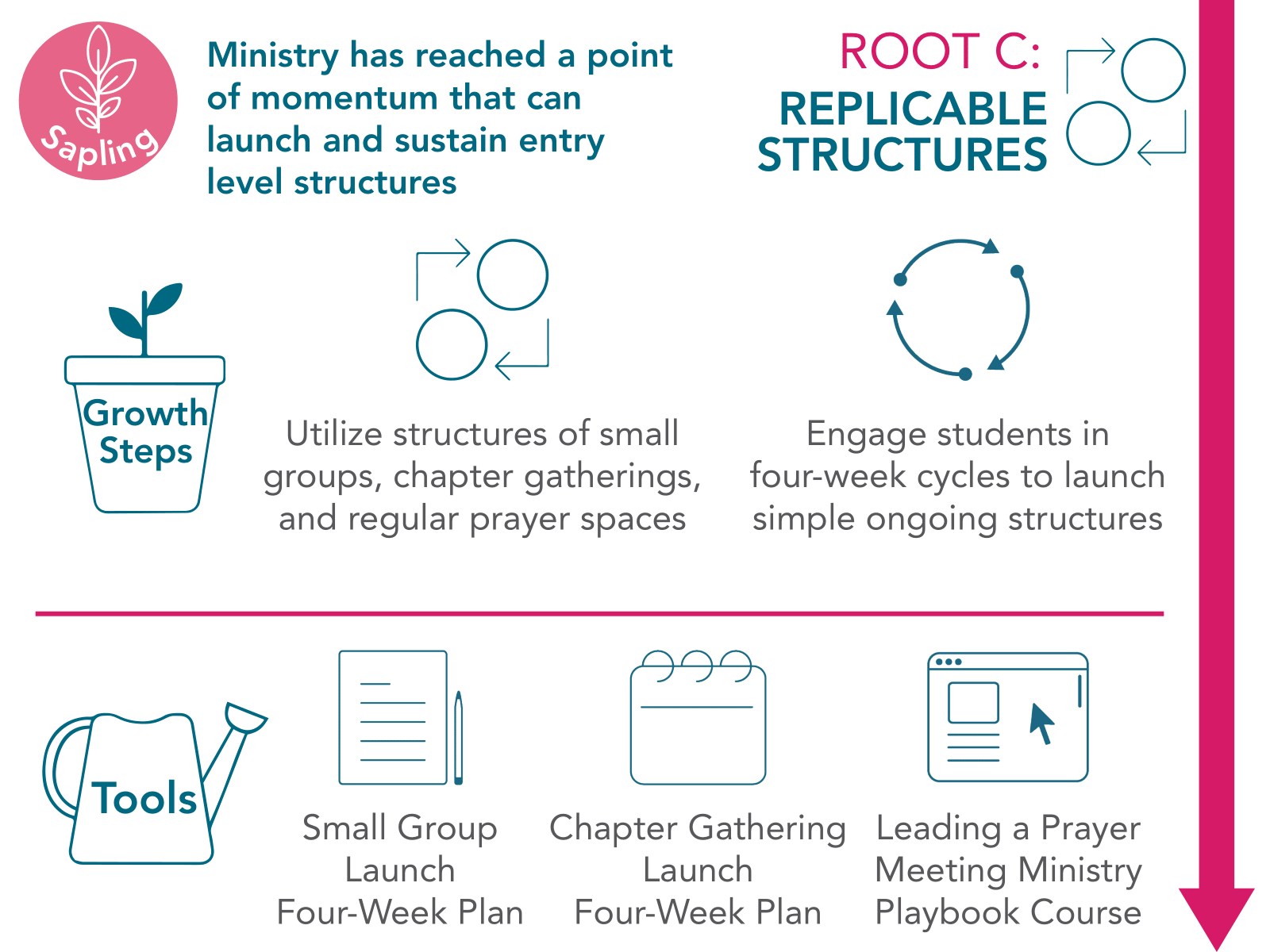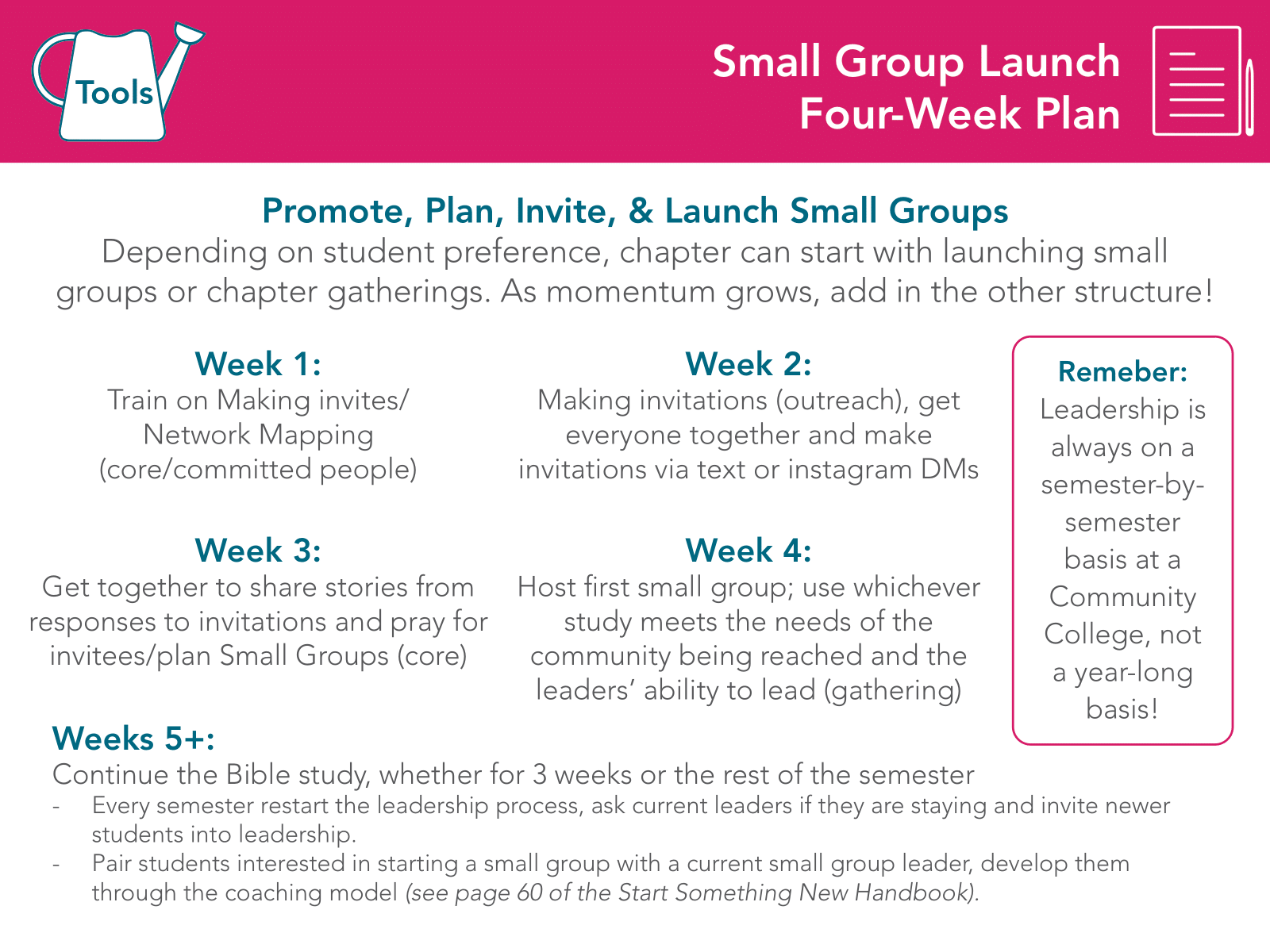Root C: Replicable Systems
Find links to tools below!
Download the full .pdf here!
LEADERSHIP ACTION STEPS
 SPROUT
SPROUT
Goal: One-off tools for quick gatherings, spiritual interest conversations, vision casting, and network engagement.
Vital Practices:
-
Prayer Walk
-
Partner Gathering
-
Tabling and/or Proxes
 SAPLING
SAPLING
Goal: Four-week cycles of outreach, missional activity, scripture engagement and prayer.
Vital Practices:
-
Small Groups
-
Chapter Gatherings
-
Prayer Spaces
 FRUIT
FRUIT
Goal: Students and volunteers train their networks to expand networks (new corners), move folks through thresholds (evangelism and discipleship), and identify new network leaders (apprenticeship).
Vital Practices:
-
Create Core Meetings, Leader Meetings, and/or Apprentice Teams
-
Monthly Multi-Chapter Gatherings
-
Pre-New Student Outreach Planning Retreats each semester
TOOLS AND RESOURCES
 SPROUT
SPROUT
-
-
Online: Prayer Walk directions here
-
-
Partner gatherings from Adopt-A-Campus
-
Online: Partner Gatherings Online
-
-
Tabling (get Vendor Table permission if your campus has this) and Proxes;
-
Online: Instagram proxes
-
-
Pocket Proxes (esp. Faith Journey Quiz)
-
Online: Faith Journey Quiz Online
-
-
Food for spiritual conversations
-
Online: “Have You Eaten Yet?” Resources (Asian American Ministries; can tailor to your campus context)
-
 SAPLING
SAPLING
-
Small Groups: promote, plan, invite, and launch small groups! You can start with this or with Chapter Gatherings, depending on whether your chapter wants to start with one specific community within one network (small groups) or with a larger community with several networks (chapter gathering). As you gather momentum, add in the others!
-
Week 1: Train on Making invites/Network Mapping (core/committed people)
-
Online: Adopt-a-Campus Online, under Prepare Your Partners; look at the guide and the video!
-
-
Week 2: Making invitations (outreach)
-
Online: this works for both in person and online; just use in via text or instagram DMs. Get everyone together on a call and make invitations on your phone/computer while ‘together’!
-
-
Week 3: Get together to share stories from responses to invitations and pray for invitees/plan Small Groups (core)
-
Online: this works for both in person and online.
-
-
Week 4: Host first small group; use whichever study meets the needs of the community being reached and the leaders’ ability to lead (gathering)
-
Online: Small group Bible studies adapted for online use
-
-
Weeks 5+: Continue the Bible study, which can go anywhere from 3 weeks to the rest of the semester (gathering)
-
Every semester, restart the leadership process; never assume current leaders will stay leaders, and always ask if there are newer students interested in leading every semester! Leadership is always on a semester-by-semester basis at a Community College, not a year-long basis!
-
If you have students interested in learning how to start a small group before the semester is over, pair them up with a current small group leader and have them learn about small group leadership through the coaching model (see page 60 of the Start Something New Handbook).
-
-
-
Chapter Gathering/Core spaces: promote, plan, invite, and launch chapter-wide gatherings! You can start with this or with Small Groups, depending on whether your chapter wants to start with one specific community within one network (small groups) or with a larger community with several networks (chapter gathering). As you gather momentum, add in the others! These were formerly called ‘Large Groups’; we often see that Large Group is a bit of a misnomer in Community College ministry as it is often smaller and more scrappy than a high-prep sort of space like a traditional 4-year college large group space.
-
Week 1: Proxe Training (core)
-
Online: Instagram Proxes - Better World or Faking It
-
-
Week 2: Proxe (outreach)
-
Online: Instagram Proxes - Better World or Faking It
-
-
Week 3: Follow up and Celebration of what God did in the time of outreach, prep and pray for Chapter Gathering Launch (core)
-
Week 4: Chapter Gathering Launch/Talk on Proxe Topic (missional activity/call to faith)
-
Online: Kickoff Event Guide
-
-
Weeks 5+: Repeat! (No regular weekly Chapter Gathering yet in this stage; see ‘Tree’)
-
-
Prayer Spaces: promote, plan, invite, and launch spaces for regular prayer!
-
Week 1: Gathering and caring/praying for one another (core);
-
Online: this is all transferable online, but feel free to peruse online prayer ministry resources
-
-
Week 2: Brief training on prayer walking (outreach) and practice
-
Online: Virtual Prayer Walk
-
-
Week 3: Praying for who they met/who is on their hearts (core); this is transferable online
-
Week 4: Treasure hunt/offering prayer on campus (missional activity)
-
Online: Ask for prayer needs on your Instagram story! Design one using Instagram Proxe designs! (Better World or Faking It)
-
-
Weeks 5+: Repeat!
-
 FRUIT
FRUIT
-
Utilize Core Meetings, Leader Meetings, and/or Apprentice Teams to raise up new leaders. Pending who is in your chapter and their capacity, as well as how much time you and your planting partners/student leaders have, will determine which option to follow! If you and your partners have a combined total of time on campus of 8 hours a week or less to give to ministry, follow the low-time option. If combined you have 8-16 hours, follow the medium-time option. If combinted you have 17 or more hours to give, follow the high-time option. As you and your team grow in capacity and time, you will be able to shift from low to medium to high. Always try to keep these meetings to an hour maximum, and realistically, more like 45 minutes.
-
Low-time option: Core Meeting/Leadership Team with Apprentices.
-
Gather all your leaders and all your apprentices to train them all up at once. Offer Bible studies that build up their character and missional activity. You could use the Start Something New Handbook for small group leadership, prayer leadership, and outreach/evangelism activity. Use this space to plan out your future cycles of outreach and core meetings, and/or to design more regular Chapter Gatherings if you have decided to make Chapter Gatherings more regular than once a month. (If there’s time, have leaders meet with their apprentices inside this meeting space to plan out their respective structures that they’re leading. If not, have them meet outside this meeting.)
-
If you have time outside of this meeting, meet with your most influential leaders in one-on-one meetings to disciple them.
-
-
Medium-time option: Have two meetings, a Leadership Team & an Apprentice Team.
-
Each team gathers to be trained up in group settings.
-
Use Leadership Team meetings to plan out chapter events and/or to prepare the spaces they are leading. Have leaders also set up separate meetings with their apprentices (which they should work to have as soon as possible; this should be a requirement to them being a leader) to prepare the study/prayer/outreach together and pass on leadership to apprentices/give them space to practice. Use the Coaching Model from the Start Something New Handbook.
-
Use the Start Something New Handbook for small group and prayer meeting apprenticeship.
-
Require apprentices to only do one or the other - be apprenticed by a leader OR go to apprenticeship meetings. Ideally they would do both, but require only one because of capacity/availability of leaders.
-
-
High-time option: Create separate weekly meeting spaces for each kind of leader and apprentice you have (small group leaders, small group apprentices, prayer leaders, outreach apprentices, etc) and, as time allows after that, one-on-one meetings with leaders first, then apprentices.
-
In each group space, go through Bible studies to grow in leadership and in multiplication of leadership into new networks.
-
In each one-on-one; go through discipleship cycles to develop each person into their own growth edges and gifts.
-
-
-
Monthly Multi-Chapter Gatherings
-
Could be of other Community Colleges across and area/region (in person or online, considering the geography), or of all colleges in a geographical area/region like a city or metropolitan area (again, taking geography and distance into account). Community College students thrive off of larger connections and community, and being able to connect with chapters of schools they may transfer to and/or students at other community colleges who will understand their experience can make a big difference for them in their InterVarsity involvement!
-
This is generally encouraged to start at least one semester into planting. You probably won’t have the capacity nor feel the need for the space in the first semester (or even in the first year?).
-
-
Pre-New Student Outreach Planning Retreats each semester
-
Bound by the beginning of each semester; as soon as you have at least 2 core students, this is a must at the beginning of each new semester!
-
This could be a 3 hour planning session, or it could be much longer (3 day retreat away), depending on the point person, the chapter, their capacity and their needs!
-







